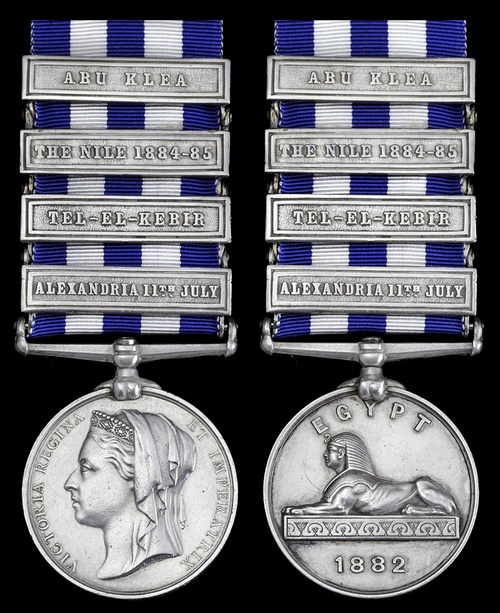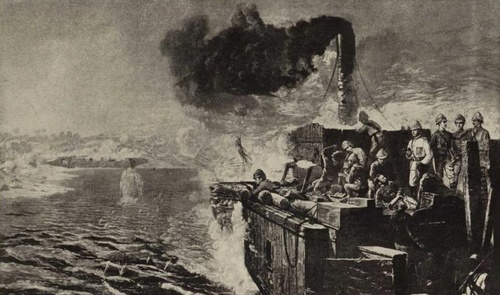Auction: 19001 - Orders, Decorations and Medals
Lot: 154
The poignant and unique Egypt Medal awarded to Captain of the Mast and Petty Officer E. Curnow, mortally wounded while manning the starboard Gardner gun aboard S.S. Safiah when in action off Wad Habeshi on the River Nile, 3 February 1885
Egypt and Sudan 1882-89, dated reverse, 4 clasps, Alexandria 11th July, Tel-el-Kebir, The Nile 1884-85, Abu Klea (E. Curnow. A.B. H.M.S. "Monarch"), minor scratch in reverse field, extremely fine
The only Medal with these four clasps to a casualty of the Royal Navy.
Edwin Curnow was born on 4 May 1859, entering the Royal Navy as a Boy 2nd Class at the age of 15. His exemplary character earned him Good Conduct badges, and he rose to Able Seaman on 4 May 1877. He served aboard H.M.S. Monarch during the 1882 campaign in Egypt, when Britain suppressed a nationalist rising led by Ahmed 'Urabi and upheld the rule of Khedive Tefwick Pasha, using him as a puppet to legitimise a British takeover. Curnow took part in the bombardment of Alexandria (clasp) on 11-13 July 1883, when for over ten hours Admiral Seymour's British fleet pulverised nationalist strongholds in the city. This preceded a full-scale British invasion in August, led by General Garnet Wolseley. Wolseley's force raced towards the Suez Canal to prevent its capture by the nationalists. This force included a Naval Gatling Gun team drawn from Monarch's crew. Curnow fought with this team at Tel-El-Kebir (clasp) on 13 September, contributing to the decisive British victory.
To Gordon's Relief
Promoted to Petty Officer 2nd Class on 10 July 1883, Curnow was stationed at Korti in northern Sudan when Mahdist forces surrounded Khartoum in April 1884. Since General Gordon had remained in Khartoum against the wishes of the British government, Gladstone's administration was reluctant to inflame tensions by attempting his rescue. It was not until 30 December that the Gordon Relief Expedition set out. Curnow was appointed Captain of the Mast with the Naval contingent assigned to Sir Herbert Stewart's 'Desert Column', which crossed the Bayuda Desert and engaged the Mahdists at Abu Klea (clasp) on 17 January 1885. Faced with overwhelming numbers, the British troops formed into a single square. A Gardner gun, a hand-cranked early machine gun, guarded the square's rear left corner and was manned by the Bluejackets, with Lord Charles Beresford, Royal Navy in command. As Dervishes swarmed around the square, Beresford saw an opportunity to enfilade them. He ordered the Gardner gun to be run out some fifty yards from the protection of the square. Unfortunately, while the gun had worked perfectly during trials in England, on this occasion loose sand got into its mechanism and it jammed after firing seventy rounds. The Dervishes seized their chance. Two officers and six men of the Naval contingent were hacked to death, eleven other Bluejackets receiving spear wounds. The Naval contingent, just forty men strong, was now totally isolated. The celebrated Colonel Frederick Burnaby, Royal Horse Guards, tried to support them with his Camel Corps but he received a spear through the neck, dying shortly afterwards. After savage fighting, the remaining Bluejackets (including Curnow) reached the safety of the square.
Sir Herbert Stewart was mortally wounded at Abu Klea, so command of the Desert Column fell to an inexperienced staff officer, Sir Charles Wilson. Reaching the Nile, the force made contact with four small steamers which had escaped from Khartoum, the Bordein, Tull-Howeija, Safiah and Tefikea. It was decided to send two back to the besieged city, taking Sir Charles with them as diplomatic envoy. The Bordein and Tull-Howeija duly left for Khartoum with Sir Charles, together with an escort of twenty men of the Royal Sussex Regiment. The remainder of the Desert Column encamped in a fortified position at Gubat, some 30 miles downstream, on 31 January. The next day, dramatic news reached Gubat with the arrival of Lieutenant Stuart Montagu-Wortley, in a small native boat, from Wilson's party. He announced that Khartoum had fallen on 26 January and that Gordon had been murdered. On nearing Khartoum the Bordein and Tull-Howeija had come under heavy fire, both vessels foundering in the Shabluka Cataract. The crews had managed to save themselves, scrambling ashore and taking up a defensive position on a small island called Mernat.
Steeling themselves for an epic rescue, Beresford's Bluejackets at once boarded S.S. Safiah. On 1 February she began the voyage upstream, as currents reduced her average speed to just 2.5 miles per hour. This defenceless wooden hulk was patently unsuited to the task, Beresford recalling that 'bullets went through her as through paper, and a shell would pierce her wooden jacket' (Beresford 1914, 296). A Gardner gun was set up on her starboard side, and this was to be Curnow's weapon in the forthcoming struggle. To reach Wilson's force, Safiah had to crawl past the powerful Mahdist garrison at Wad Habeshi. In his memoirs, Beresford described the action:
'Wad Habeshi was a strong earthwork, with four embrasures, mounting four guns, and manned, according to Stuart-Wortley's report, by 5,000 riflemen. The only practicable channel ran within 80 yards of the fort. We could only crawl past the battery, and as we were defenceless against gun-fire, our only chance was to maintain so overwhelming a fire upon the embrasures as to demoralise the guns' crews. It was an extreme instance of the principle that the best defence resides in gun-fire rather than in armour; for we had no effective armour.
Accordingly, the starboard Gardner and the two brass guns, the 20 soldiers and 14 Bluejackets, poured a steady and accurate fire into the fort, disregarding the parties of riflemen who were shooting at us from the bank. There were some 600 or 800 of these, and one gun opened fire from the side embrasure of the fort. Poor von Koughnet was shot in the leg, and Second-Class Petty Officer Edwin Curnow, number two of the crew of the starboard Gardner, fell mortally wounded, and died that evening.'
Safiah's boiler was shot through during the firefight, and she was forced to anchor in a storm of bullets and shells while Chief Engineer Henry Benbow made repairs. Curnow's bravery in manning the Gardner gun under such conditions can well be imagined. In the painting Running the Gauntlet, owned by the Marquess of Waterford, he can be seen falling mortally wounded next to the Gardner gun.
Curnow's sacrifice was not in vain. Despite heavy losses, Safiah continued on her perilous journey, the crew working frantically to repair her damaged hull under relentless Mahdist fire. Reaching Mernat Island, she rescued Sir Charles Wilson and the crewmen, a miraculous feat which left the Dervishes stunned. One of the Mahdi's prisoners, Father Orhwalder, wrote that after Beresford's victory at Wad Habeshi the Dervishes 'would dread meeting the English on the river.' For his services Beresford was made a Companion of the Bath. Curnow's death was reported in The London Gazette of 28 April 1855, while his service papers confirmed him as 'Discharged Dead, Killed in Action'; sold with copied service papers, clasp confirmation (ADM 171/41 and ADM 171/43) and research.
Recommended reading:
Beresford, Lord C., Memoirs of Lord Charles Beresford (London, 1914).
Crook, M. J., 'The Royal Navy in Egypt and the Sudan, 1882-1888,' Journal of the Orders and Medals Research Society, Spring 1974, p. 20 f.
Subject to 20% VAT on Buyer’s Premium. For more information please view Terms and Conditions for Buyers.
Sold for
£8,000







